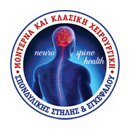What is the basic anatomy of the intervertebral disc?
The shape of a normal intervertebral disc is cylindrical. It is surrounded by fibrocartilage, a fibrous ring that helps it to connect with the neighboring vertebrae. In its center, it includes a softer tissue, the nucleus pulposus, which gives it its immense flexibility.
What is the purpose of the intervertebral discs?
Intervertebral discs allow the significant mobility of the spine while they support and distribute the weight of the body, that is, they act as shock absorbers.
How does a herniated disc occur?
As we get older and we regularly stress our intervertebral discs, the nucleus pulposus dries out and its structure gets damaged (degeneration) while the fibrous ring, surrounding the damaged and now flexible nucleus pulposus, shows signs of fissure. Therefore, abrupt movements and weight lifting are now using forces that squeeze the nucleus pulposus through the fibers of the fibrous ring and this causes a herniated disc. On rare cases, a lumbar spine injury can cause the sudden creation of a herniated disc in the lower back (traumatic disc herniation).
What are the symptoms of a lower back herniated disc?
Symptoms depend on the position of the herniated disc. When it is near the spinal canal, that is, near the part of the spine that includes the nerves, then intense pain is felt in the lower back and/or the leg (sciatica).
https://www.neuroxeirourgos.gr/en/nosoi-kai-symptomata/spondilikis-stilis/osfialgia-ke-ischialgia/
If the position of the herniated disc is central, then the main symptom is lower back pain and if the position is lateral, the main symptom is sciatica, which is characterized by a unique sign; it feels better when the patient bends their knee. The pain caused by a herniated disc in the lower back gets worse when the patient coughs or sneezes. Finally, a herniated disc in the lower back may cause symptoms such as incontinence or the inability to completely empty the bladder (urinary retention).
How are lower back herniated discs treated?
Lower back herniated discs are initially treated conservatively. Conservative treatment includes change of activities (prevention of weight lifting, not sitting for a prolonged period of time, and shock prevention), painkillers and muscle-relaxants, as well as physical therapy consisting of exercise and patient’s training on the correct posture, on the right sleep position, and on the correct way of lifting weights. There is also another series of conservative measures that haven’t been scientifically proven but they seem to have a temporary effect, such as chiropractic (which at the same time may be dangerous for the patient’s neurological integrity), epidural cortisone injections, local anesthetics and opioids, anti-depressant pills, transcutaneous electrical nerve stimulation (TENS), pull-ups, massage, diathermy, ultrasounds, and more. Modic antibiotic spine therapy (MAST), that is, antibiotic treatment for at least 3 months, with or without the administration of intradiscal gel (discoplasty and MAST treatment), is one of the most hopeful and modern treatment methods when the herniation size is not very big.
Urgent cases
Serious or prolonged nerve compression by a herniated disc may cause progressive leg muscle weakness, which may become permanent if nerve decompression doesn’t take place as soon as possible. Massive disc prolapse, for example, a sudden appearance of a large disc herniation that compresses all nerves within the spinal canal, can cause a relatively rare (1–2% of all surgically treated herniated discs) condition, called cauda equina syndrome that is characterized by sudden weakness in both legs, leg and external genitalia numbness, as well as urination and defecation disorders. This condition requires immediate surgical treatment (laminectomy and discectomy) within the first few hours of the symptom’s appearance.
What are the surgical treatment indications of the lower back herniated discs?
Surgical treatment is not always required for a lower back herniated disc since 85% of the acute herniation is self-healed within the first 6 weeks. The aforementioned urgent cases (progressive leg muscle weakness and cauda equina syndrome) as well as herniated discs causing excruciating pain (lower back pain and sciatica) that don’t respond to the correct conservative treatment are always treated surgically.
What is the main surgical discectomy method?
Microdiscectomy, which is discectomy that takes place with the support of a surgical microscope (lumbar microdiscectomy) and microsurgical tools and techniques, is the most reliable way of removing a lower back herniated disc.






